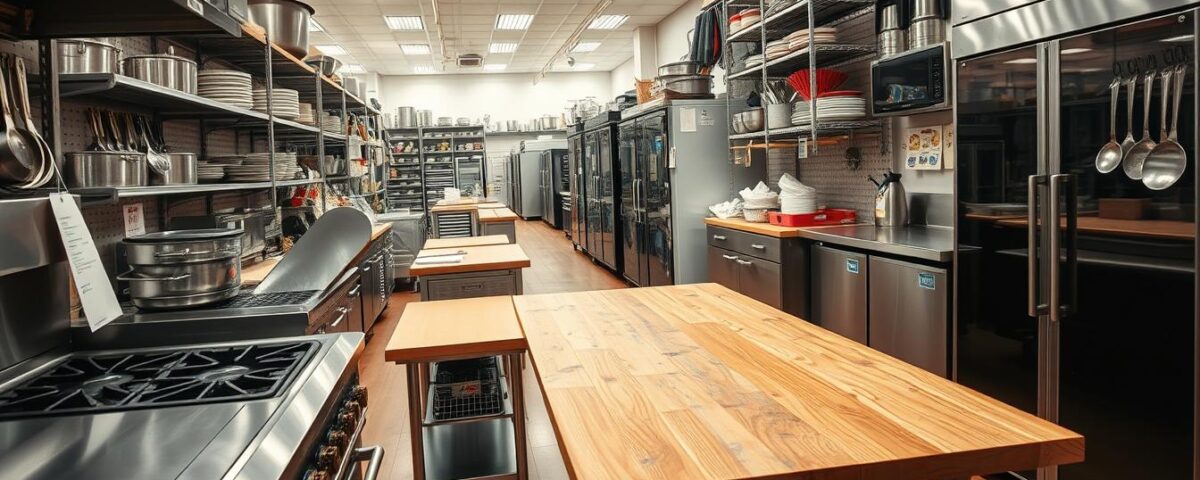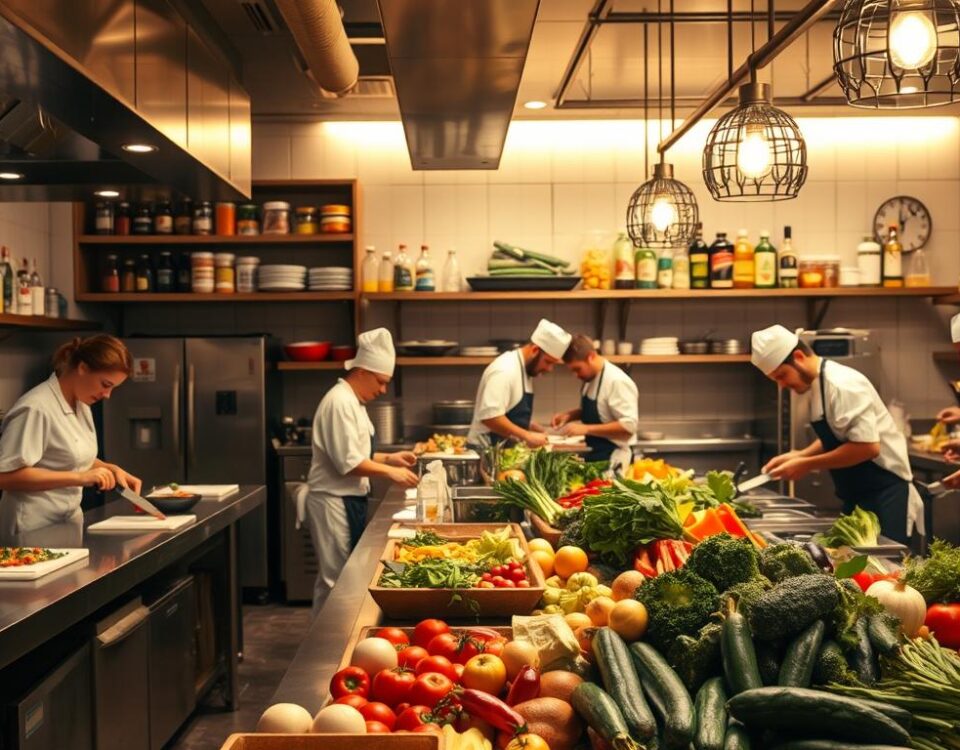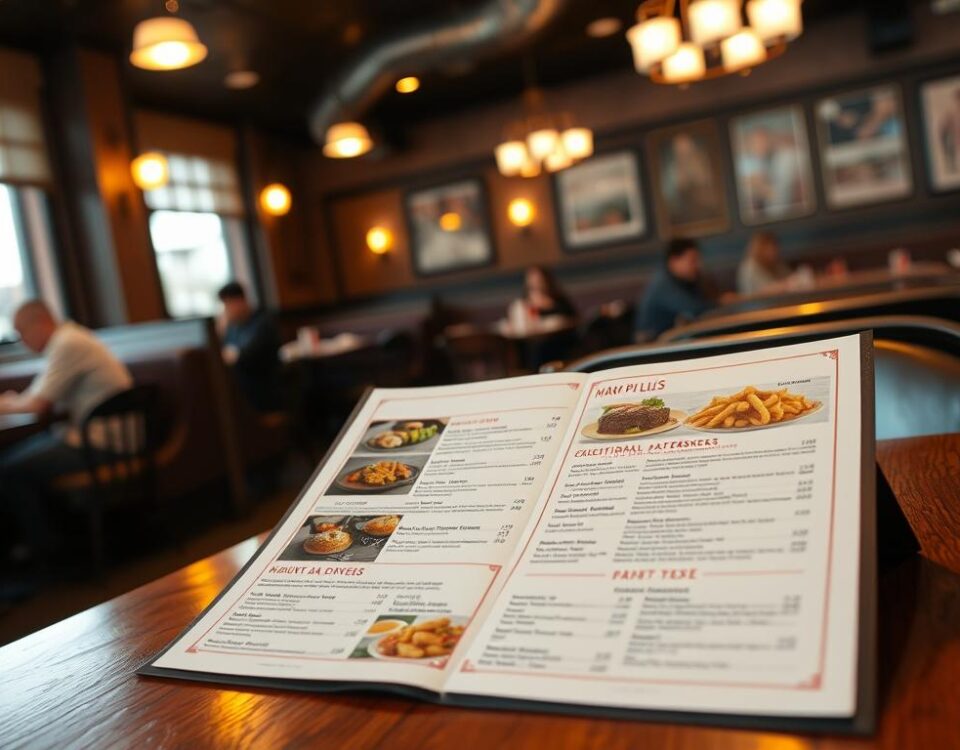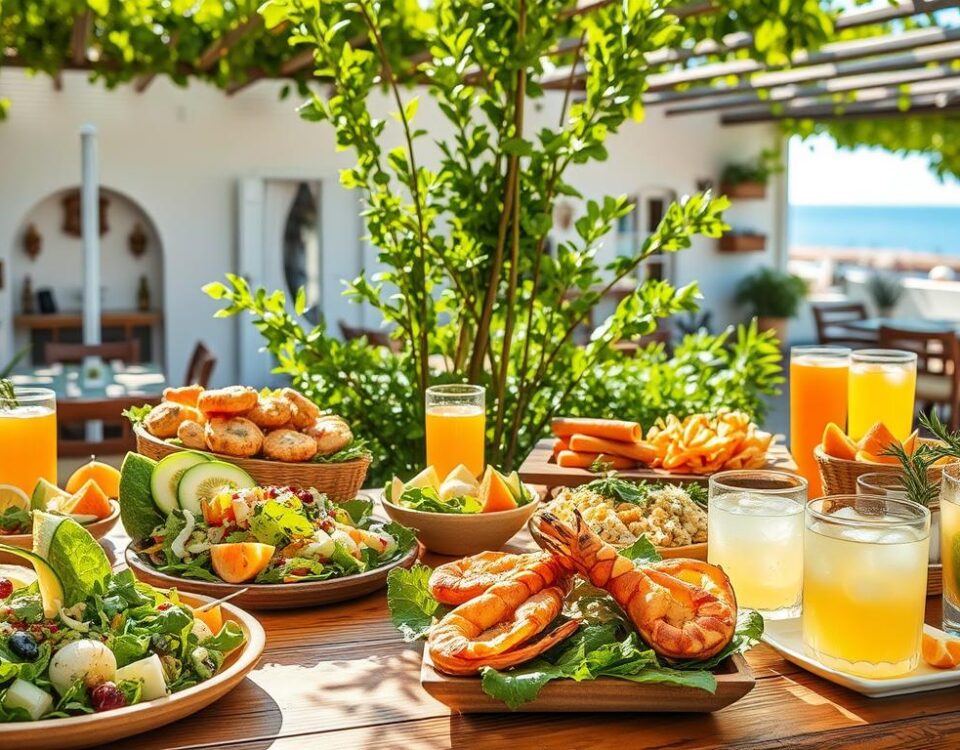
6 Hidden Benefits of Restaurant Inventory Software That Boost Profit Margins
July 20, 2025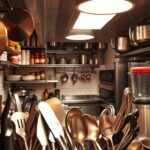
Top 10 Local Restaurant Supply Wholesalers You Need to Know
July 21, 2025I still remember the frustration I felt when I first started my restaurant business and encountered unexpected issues with the equipment I purchased from a nearby supplier. It was a costly lesson that taught me the importance of being aware of the potential pitfalls.
Did you know that many restaurant owners face similar challenges when buying from local suppliers? A surprising number of businesses end up with subpar equipment or poor service, which can significantly impact their bottom line.
As someone with years of experience in the industry, I’m here to share the hidden traps you should watch out for when purchasing from local suppliers, and how you can avoid them to ensure a successful business.
Key Takeaways
- Understand the common pitfalls when buying from local suppliers
- Learn how to avoid costly mistakes when purchasing equipment
- Discover the importance of doing thorough research before making a purchase
- Find out how to ensure you’re getting the best value for your money
- Get tips on how to navigate the challenges of buying from local suppliers
My Experience with Restaurant Supply Stores
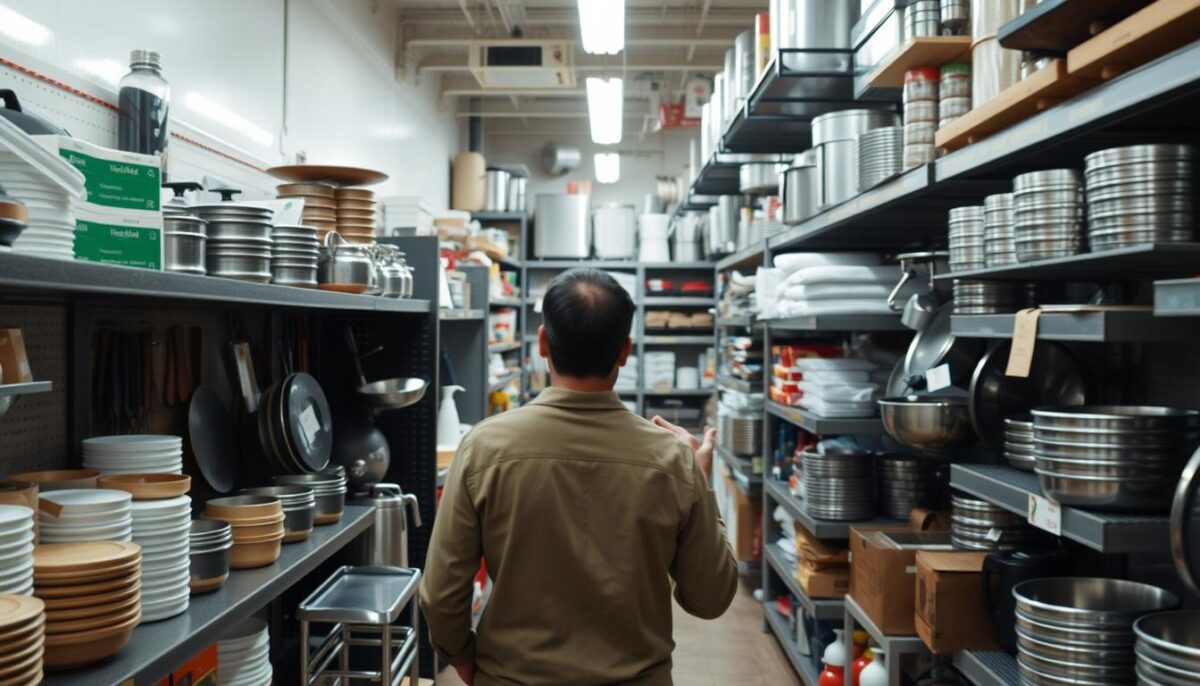
As a novice restaurateur, my initial foray into local restaurant supply stores was a mix of discovery and frustration. Since The Restaurant Warehouse launched its website in 2015, it has been serving all commercial kitchens, food trucks, bakeries, and delis with competitive pricing, making it a valuable resource for entrepreneurs like me.
I vividly remember the excitement of shopping for equipment at local supply stores when opening my first restaurant. However, my initial assumptions about pricing, quality, and service were quickly challenged as I navigated the complex world of restaurant supply. There were instances where I made costly mistakes due to a lack of industry knowledge and high-pressure sales tactics.
The learning curve was steep, but these experiences taught me valuable lessons about how the restaurant supply industry operates. I eventually developed strategies to identify reputable suppliers and avoid common pitfalls. My experiences mirror those of many restaurant owners who enter the industry with a passion for food but limited knowledge of equipment purchasing.
These early mistakes had a significant impact on my business’s profitability and operations. This personal narrative sets the stage for understanding why it’s crucial to be aware of the hidden traps in the restaurant supply industry. By sharing my journey, I aim to help others navigate this challenging landscape more effectively.
Understanding the Restaurant Supply Industry
To navigate the restaurant supply market effectively, it’s crucial to understand its underlying structure. The restaurant supply industry involves various stakeholders, including manufacturers, distributors, and local retailers. This complex ecosystem influences the availability, pricing, and quality of restaurant equipment.
The Importance of Quality Equipment for Restaurant Success
Quality equipment is vital for a restaurant’s success, impacting food quality, customer satisfaction, and operational efficiency. Investing in high-quality commercial kitchen equipment may seem costly upfront, but it reduces long-term expenses by minimizing repairs and replacements.
How Local Restaurant Supply Stores Operate
Local restaurant supply stores typically operate through high-rent showrooms or affiliate schemes, driving up prices. Many use commission-based sales models, with sales teams earning 20%-50% commissions, further inflating costs. Understanding these dynamics helps restaurateurs make informed decisions when purchasing restaurant equipment.
Why Restaurant Owners Fall Into Local Restaurant Supply Store Traps
The world of local restaurant supply stores is fraught with pitfalls that can ensnare even the most cautious restaurateurs. Running a restaurant, hotel, catering service, or food truck requires a significant amount of time, attention, and resources. As a restaurant owner, I’ve often found myself navigating these challenges, and I’ve come to realize that certain factors make us vulnerable to the traps set by local supply stores.
Time Constraints and Urgency
One major factor is the intense time pressure of opening a restaurant. This urgency can lead to hasty, uninformed purchasing decisions. The excitement and stress of launching a new business can cloud judgment when buying equipment. Moreover, the high failure rate in the restaurant industry creates additional pressure to get up and running quickly.
Limited Knowledge of Equipment Specifications
Many first-time restaurant owners, like myself when I was starting out, lack technical knowledge about equipment specifications. This knowledge gap makes it difficult to evaluate claims made by salespeople at the supply store. Sometimes, these stores take advantage of this gap to upsell unnecessary features or lower-quality products. Understanding these vulnerabilities is the first step in developing strategies to overcome them and make informed purchasing decisions.
Trap #1: Inflated Pricing Structures
One of the hidden dangers of purchasing from local restaurant supply stores is the inflated pricing structures that can blow your budget. As a restaurant owner, you’re likely to encounter various pricing models, but not all of them are transparent or fair.
Commission-Based Sales Models
Many restaurant supply stores operate on commission-based sales models, which can lead to significantly inflated equipment prices. For instance, a salesperson might be incentivized to push high-commission items like sandwich prep tables or pizza prep tables rather than what your restaurant actually needs. This can result in unnecessary expenses and a bloated budget.
I’ve seen cases where a piece of equipment that costs $1,000 wholesale is priced at $2,500 or more due to these commission-based sales models. This kind of markup can be detrimental to your bottom line, especially if you’re not aware of the actual market price.
Hidden Fees and Delivery Charges
In addition to inflated equipment prices, many restaurant supply stores also charge hidden fees that can add to your overall costs. These might include delivery charges, installation fees, and “processing fees” that aren’t always apparent until you receive the final invoice.
I’ve experienced this firsthand, being quoted one price initially only to find the final bill much higher due to these additional charges. To avoid this trap, it’s essential to carefully review the pricing structure and ask about any potential fees before making a purchase.
By understanding how commission-based sales models and hidden fees contribute to inflated pricing structures, you can make more informed decisions when purchasing restaurant equipment. Consider exploring alternative options like restaurant warehouse suppliers, which often offer more transparent pricing models.
Trap #2: Questionable Equipment Quality
One of the hidden traps in buying from local restaurant supply stores is the risk of receiving low-quality restaurant equipment. As a restaurant owner, it’s crucial to understand that the quality of your equipment directly impacts your business’s efficiency, food safety, and customer satisfaction.
When browsing through a supply store’s catalog or website, it’s easy to get caught up in the features and prices of various equipment. However, not all equipment is created equal. Some supply stores may offer knockoff brands or lower-quality alternatives that appear similar to industry-standard brands but lack the same level of performance and durability.
Knockoff Brands vs. Industry Standards
I’ve seen instances where restaurant owners unknowingly purchase counterfeit or substandard equipment, thinking they’re getting a genuine product. For example, a sandwich prep table that looks identical to a name-brand unit might be available at a lower price. However, upon closer inspection, you might find that it’s made with inferior materials and lacks the advanced features that make the genuine product reliable and efficient.
To avoid falling into this trap, it’s essential to inspect the equipment carefully and research the manufacturer’s reputation. Look for quality markers such as high-quality metals, advanced technologies, and components designed to optimize performance. For instance, refrigeration units built with high-density, CFC-free polyurethane insulation are not only more energy-efficient but also more environmentally friendly.
Energy Efficiency Concerns
Another critical aspect to consider when evaluating restaurant equipment is energy efficiency. Many restaurant owners overlook this factor when purchasing equipment like refrigeration units and cooking appliances. However, energy-efficient equipment can significantly reduce your operational costs in the long run.
I recall a personal experience where I purchased a sandwich prep table that consumed nearly twice the electricity as the name-brand unit it was modeled after. The difference in energy consumption was substantial, and it had a direct impact on my utility bills. When shopping for equipment like pizza prep tables or other refrigerated units, make sure to check the energy ratings and look for features that promote energy efficiency.
By being mindful of the quality and energy efficiency of your restaurant equipment, you can avoid the trap of questionable equipment quality and ensure that your business runs smoothly and cost-effectively.
Trap #3: Misleading Warranty Terms
Deceptive warranty practices can make seemingly competitive offers from local restaurant supply stores much more expensive in the long run. As a restaurant owner, it’s essential to understand the warranty terms when purchasing restaurant equipment.
Some supply stores use misleading warranty terms to appear competitive while limiting their actual liability. For instance, a “two-year parts and labor warranty” might sound comprehensive, but the fine print could exclude critical components or labor costs associated with repairs.
Understanding Parts and Labor Coverage
The difference between parts-only and parts-and-labor warranties is significant. Labor costs often exceed the cost of parts for repairs, especially for complex equipment like commercial refrigeration units or sandwich prep tables.
For example, a parts-only warranty might cover the cost of a replacement compressor, but not the labor required to install it. In contrast, a parts-and-labor warranty covers both the parts and the labor costs, providing more comprehensive protection.
| Warranty Type | Parts Coverage | Labor Coverage |
|---|---|---|
| Parts-Only | Yes | No |
| Parts-and-Labor | Yes | Yes |
When evaluating warranty offerings, it’s crucial to read the fine print and understand what’s covered. Some warranties may have exclusions or limitations that render them nearly useless.
Compressor Warranty Limitations
Compressor warranties for refrigeration equipment are particularly important, as compressor failures can be costly. A five-year compressor warranty might seem comprehensive, but it may only cover the compressor itself, not the labor required to replace it.
For instance, True offers a 7-year warranty on all parts, labor, and compressor. This comprehensive coverage provides peace of mind for restaurant owners, knowing that they’re protected against costly repairs.
When purchasing restaurant equipment, it’s essential to evaluate the warranty offerings critically and negotiate for truly valuable coverage. By understanding the warranty terms and what’s covered, restaurant owners can avoid unexpected repair costs and ensure that their equipment remains in good working order.
Trap #4: Inadequate After-Sale Support
The true value of a restaurant supply store lies in its after-sale service. When I purchased my restaurant equipment, I didn’t realize that the real challenge would come after the sale was complete. Many local restaurant supply stores promise the world, but their support often disappears once the payment clears.
Customer Service Challenges
One of the most frustrating experiences I’ve had was trying to get help when my sandwich prep equipment failed during a busy service period. The customer service was unresponsive, and I was left with a long wait for a service technician. Some supply stores outsource their service calls to third-party technicians who aren’t familiar with the equipment they sold you, leading to further delays and complications.

Maintenance and Repair Issues
Maintenance requirements are often not disclosed at the time of purchase, leaving restaurant owners with unexpected costs and challenges. Specialized cleaning procedures and preventative maintenance are crucial for the longevity of your equipment. I recall being told that a service technician would arrive “sometime between 8am and 5pm” during busy restaurant hours, which wasn’t helpful. To avoid such issues, it’s essential to verify a supplier’s service reputation before purchasing.
By understanding the potential pitfalls in after-sale support, restaurant owners can make informed decisions when buying from local restaurant supply stores. It’s crucial to prioritize customer service and maintenance support to ensure the longevity of your restaurant equipment.
Trap #5: Financing Pitfalls
Restaurant owners often face a hidden trap when they opt for financing options from restaurant supply stores. While financing can provide the necessary capital for equipment purchases, some arrangements can lead to costly long-term commitments.
One of the primary concerns with financing options is the high-interest rates associated with them. Some financing arrangements feature interest rates ranging from 15% to 30%, significantly increasing the total cost of the equipment.
High-Interest Financing Options
High-interest financing options can be particularly problematic for restaurant owners. These options may offer low monthly payments, making them appear affordable at first glance. However, the total cost over the financing period can be thousands of dollars more than the initial equipment cost.
For instance, a $10,000 sandwich prep table financed over 5 years at an interest rate of 20% can end up costing the restaurant owner over $14,000. This significant increase in cost can strain the restaurant’s finances and impact its profitability.
| Equipment Cost | Interest Rate | Financing Period | Total Cost |
|---|---|---|---|
| $10,000 | 20% | 5 years | $14,386.20 |
| $5,000 | 15% | 3 years | $6,412.50 |
| $8,000 | 25% | 4 years | $12,800 |
Lease-to-Own Disadvantages
Lease-to-own arrangements are another financing option that can be detrimental to restaurant owners. While they may provide lower upfront costs, they often result in paying 150% to 200% of the equipment’s original value over the lease period.
For example, leasing a pizza prep table worth $8,000 can end up costing the restaurant $12,000 to $16,000 over a 5-year lease period. This can be a significant financial burden, especially for small restaurants.
To avoid these financing pitfalls, restaurant owners should explore alternative financing options that offer more favorable terms. It’s essential to carefully review the financing agreement, understanding all the terms and conditions before signing.
How to Identify Reliable Restaurant Supply Stores
To avoid potential pitfalls, it’s essential to know how to evaluate restaurant supply stores effectively. When searching for a reliable supplier, there are several key factors to consider. A trustworthy supplier can make a significant difference in the success of your restaurant by providing high-quality equipment and excellent customer service.
Reputation and Reviews
One of the first steps in identifying a reliable restaurant supply store is to research its reputation. This can be done by reading reviews on platforms specific to the restaurant industry, such as Yelp or Google Reviews. Additionally, industry forums and social media groups can provide valuable insights into a supplier’s reputation. For instance, a supplier like Chefs’ Toys in Commerce is known for its warm and welcoming environment, driven by great customer service and extensive restaurant equipment knowledge.
Some red flags to watch out for include high staff turnover, reluctance to provide references, or pushy sales tactics. A reliable supplier should be transparent about their products and services, and willing to provide references upon request.
Industry Certifications and Partnerships
Industry certifications and manufacturer partnerships are also important indicators of a supplier’s legitimacy. Authorized dealer status, for example, ensures that the supplier is qualified to sell specific brands and provide warranty services. When evaluating a supplier, look for certifications from reputable organizations and check if they have partnerships with well-known manufacturers.
| Certification/Partnership | Description | Benefits |
|---|---|---|
| Authorized Dealer Status | Qualified to sell specific brands and provide warranty services | Ensures genuine products and reliable warranty support |
| Industry Certifications | Certifications from reputable organizations | Demonstrates expertise and adherence to industry standards |
| Manufacturer Partnerships | Partnerships with well-known manufacturers | Access to high-quality products and potentially better pricing |
By considering these factors and doing your due diligence, you can identify a reliable restaurant supply store that meets your needs and helps your business thrive. Conducting a site visit to a potential supplier and asking the right questions can also help assess their knowledge and reliability.
Essential Questions to Ask Before Purchasing
Before making a purchase from a restaurant supply store, it’s crucial to ask the right questions. This ensures that you’re making an informed decision and getting the right equipment for your needs.
Equipment Specifications and Performance
When purchasingrestaurant equipment, it’s essential to request detailed specifications, including power requirements, capacity, and performance metrics. For instance, if you’re buying a refrigeration unit, ask about its cooling capacity and energy efficiency. I recall a supplier explaining that each of their refrigeration units undergoes a 100% run test before being released to customers, running for at least 24 hours to ensure they meet quality standards. Asking about testing procedures and quality control can reveal whether the equipment meets industry standards.
Warranty and Service Agreements
Understanding the warranty and service agreements is vital. Ask about the length of the warranty, what’s covered, and the process for making claims. Inquire aboutparts laborcoverage and whether the supplier uses in-house technicians or third-party services for repairs. For example, you might ask, “What’s the typical timeframe for repairs, and are there any additional costs for emergency services?” Documenting the responses to these questions can help hold suppliers accountable later if issues arise.
By asking the right questions, you can have more productive conversations with suppliers and make more informed purchasing decisions. This includes inquiring about delivery, installation, and training to ensure these critical aspects aren’t overlooked. Whether you’re purchasingsandwich preporpizza prepequipment, being prepared with a list of essential questions can save you time and money in the long run.
New vs. Used Restaurant Equipment Considerations
Purchasing restaurant equipment is a significant investment, and understanding the pros and cons of new versus used equipment is crucial. As a restaurant owner, you need to weigh the benefits and drawbacks of each option carefully.
When considering used restaurant equipment, it’s essential to evaluate its condition, maintenance history, and remaining useful life. Used equipment can be a cost-effective option for certain categories, such as prep tables or commercial refrigerators, where the initial depreciation hit has already been taken by the previous owner.
When Used Equipment Makes Sense
Used equipment can be a viable option for restaurants with limited budgets or those looking to expand their operations quickly. For instance, a sandwich prep table or a pizza prep counter can be purchased used and still provide years of reliable service.
| Equipment Type | New or Used | Considerations |
|---|---|---|
| Refrigeration Units | New or Used | Energy efficiency, reliability |
| Cooking Equipment | New | High usage, safety concerns |
| Prep Tables | Used | Cost-effective, less wear |
When to Invest in New Equipment
For high-usage equipment like ovens or dishwashers, investing in new equipment is often the better choice. New equipment comes with warranties, rebates, and the latest energy-efficient technology, which can lead to long-term savings.
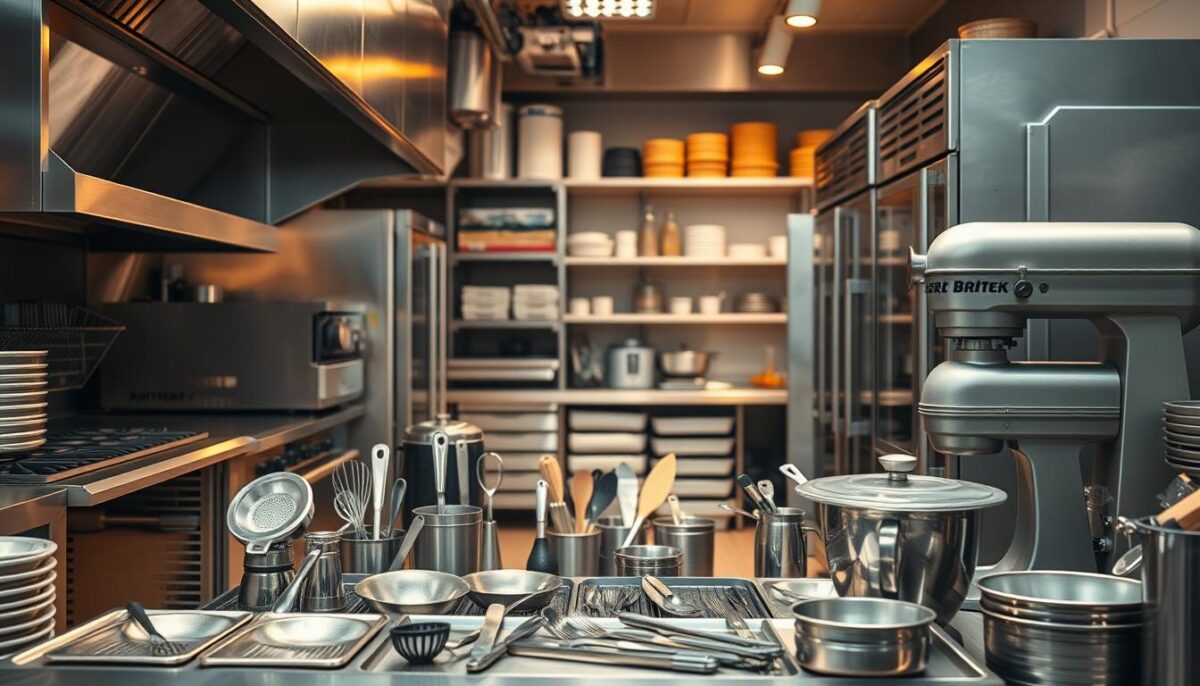
In conclusion, the decision between new and used restaurant equipment depends on various factors, including the type of equipment, budget, and operational needs. By carefully evaluating these factors, restaurant owners can make informed decisions that support their business goals.
Online vs. Physical Restaurant Supply Stores
In my experience, both online and physical restaurant supply stores have their unique advantages and disadvantages when it comes to purchasing restaurant equipment. At The Restaurant Warehouse, we provide a convenient solution for foodservice professionals to easily shop for the equipment they need.
Benefits of Online Shopping
Shopping online for restaurant equipment offers several benefits, including lower prices due to reduced overhead costs and the convenience of comparison shopping from the comfort of your own office or home. Online retailers also allow you to research products thoroughly without the pressure of a salesperson. However, it’s crucial to be aware of potential shipping damage when ordering large equipment online.
- Lower prices due to reduced overhead
- Convenience of comparison shopping
- Ability to research products thoroughly
Advantages of In-Person Shopping
On the other hand, visiting a physical store allows you to see and test equipment in person, which is particularly important for complex items like sandwich prep and pizza prep equipment. You can assess the quality and functionality firsthand, ensuring that the equipment meets your needs. Some suppliers, like The Restaurant Warehouse, offer a hybrid model that combines the benefits of both online and in-person shopping.
Key Equipment Categories and What to Look For
Selecting the appropriate equipment for your restaurant involves understanding the primary categories and their requirements. When outfitting a commercial kitchen, it’s essential to focus on the equipment that will have the most significant impact on your operations.
Refrigeration and Freezers
Refrigeration and freezers are critical components of any commercial kitchen. When evaluating these units, consider factors such as proper insulation, compressor quality, and temperature consistency. Look for energy efficiency ratings, door seal quality, and the materials used in the interior construction. A well-insulated commercial freezer, for instance, will maintain consistent temperatures and reduce energy costs.
Cooking Equipment and Food Prep
Cooking equipment, including ranges, ovens, deep fryers, and griddles, is vital for food preparation. When selecting cooking equipment, consider the features that impact food quality and operational efficiency. For example, deep fryers with advanced temperature control can help achieve consistent results. Additionally, prep tables, such as pizza prep tables and sandwich prep tables, are designed to keep ingredients organized and at the right temperature. Look for durability and ease of cleaning when choosing these units.
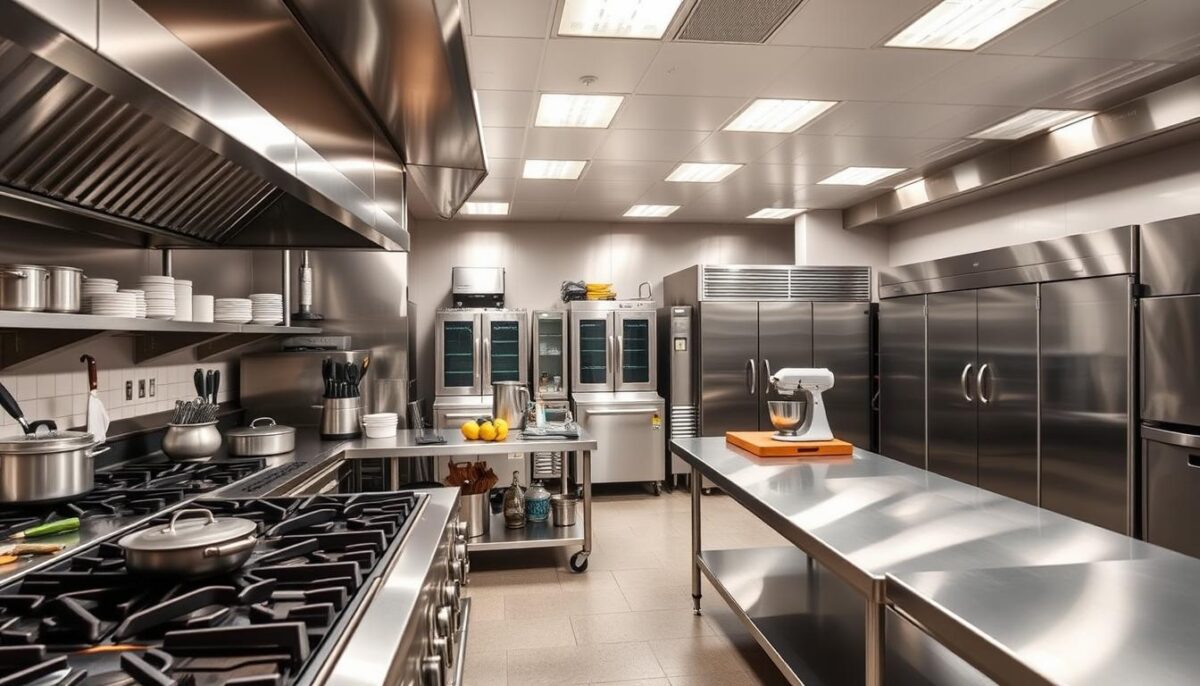
By understanding the key equipment categories and what to look for in each, restaurant owners can make informed decisions that support their menu and volume requirements. This knowledge helps avoid common pitfalls and ensures that the chosen equipment meets the specific needs of the operation.
Budget Planning for Restaurant Equipment Purchases
Effective budget planning is crucial for restaurant owners when purchasing equipment. As a restaurant owner, you need to consider not just the initial cost but the total cost of ownership, including installation, energy consumption, maintenance, and eventual replacement.
Calculating Total Cost of Ownership
To calculate the total cost of ownership, you need to consider several factors beyond the purchase price. This includes installation costs, energy efficiency, maintenance requirements, and the expected lifespan of the equipment. For instance, energy-efficient equipment might be more expensive upfront but can save you money in the long run.
| Equipment | Purchase Price | Installation Cost | Annual Energy Cost |
|---|---|---|---|
| Commercial Oven | $5,000 | $500 | $1,000 |
| Pizza Prep Tables | $2,000 | $200 | $500 |
| Sandwich Prep Tables | $1,500 | $150 | $300 |
Prioritizing Essential Equipment
Prioritizing equipment purchases based on their impact on food quality, operational efficiency, and revenue generation is essential. For example, investing in high-quality pizza prep tables and sandwich prep tables can improve food preparation efficiency and quality, directly impacting customer satisfaction and revenue.
Key Considerations: Assess your business needs, allocate budget to essential equipment, and consider phased purchasing if capital is limited.
Alternative Purchasing Options

Alternative purchasing channels for restaurant equipment can offer significant advantages over traditional methods. As a restaurant owner, exploring these options can lead to cost savings, better warranty coverage, and improved technical support.
Direct-from-Manufacturer Benefits
Buying commercial kitchen equipment directly from manufacturers can have several benefits. These include better warranty coverage, technical support, and sometimes lower prices due to the elimination of intermediaries. For instance, purchasing a commercial freezer directly from the manufacturer can ensure that you receive a product that meets your specific needs, along with comprehensive after-sales support.
Restaurant Equipment Auctions
Used restaurant equipment can be found at auctions, which can be a cost-effective way to acquire necessary items. However, it’s crucial to inspect the equipment thoroughly and understand the auction terms to avoid potential pitfalls. Auctions can be a great source for cooking equipment and other essential kitchen items, but buyers must be cautious and well-informed.
By considering alternative purchasing options, restaurant owners can make more informed decisions about their equipment needs, potentially saving time and money. Whether it’s through direct-from-manufacturer purchases or auctions, these channels can provide valuable opportunities for restaurants to upgrade or acquire the necessary equipment.
My Recommendations for Smart Equipment Purchasing
As a seasoned expert in the restaurant industry, I’m excited to share my personal recommendations for smart equipment purchasing. For scrappy startups, noble food trucks, and humble kitchens, making informed decisions about restaurant equipment is crucial for success.
When evaluating suppliers, I emphasize the importance of excellent customer service. A reputable supplier should provide comprehensive support, including timely delivery, clear communication, and reliable after-sales service. My personal checklist for evaluating suppliers includes assessing their reputation, industry certifications, and partnerships.
For different types of restaurant operations, specific considerations apply. For instance, food trucks require compact, efficient equipment that can withstand the rigors of mobile operation. In contrast, full-service establishments may prioritize high-capacity equipment that can handle a high volume of customers.
| Equipment Type | Considerations | Recommended Suppliers |
|---|---|---|
| Refrigeration | Energy efficiency, capacity | Manufacturer X, Supplier Y |
| Cooking Equipment | Performance, durability | Manufacturer Z, Supplier W |
| Used Restaurant Equipment | Condition, warranty | Supplier V, Auction House U |
By being mindful of these factors and building relationships with reputable suppliers, restaurant owners can make informed decisions that support their long-term success.
Conclusion
In the competitive foodservice industry, smart equipment decisions can be a game-changer. As we’ve explored, purchasing from local restaurant supply stores comes with its challenges, including inflated pricing structures, questionable equipment quality, misleading warranty terms, inadequate after-sale support, and financing pitfalls.
To navigate these traps, it’s essential to conduct thorough research on both the equipment and the suppliers. Building a relationship with a reputable supplier who understands your restaurant’s specific needs can significantly impact your operations and profitability. Viewing equipment purchases as strategic investments rather than mere expenses is crucial for long-term success.
By being informed and diligent, you can make equipment purchasing decisions that enhance your kitchen’s efficiency and contribute to the overall success of your restaurant. Today, with the right knowledge and partners, you can start making profitable decisions that will benefit your business over time.
FAQ
What are the benefits of buying commercial kitchen equipment from a reputable supplier?
Buying from a reputable supplier ensures that I get high-quality equipment, reliable customer service, and comprehensive warranty coverage, ultimately saving me time and money in the long run.
How do I know if I’m getting a good deal on restaurant equipment?
To determine if I’m getting a good deal, I compare prices from different suppliers, consider the total cost of ownership, and look for industry certifications and partnerships that ensure the equipment meets industry standards.
What are some common pitfalls to watch out for when purchasing used restaurant equipment?
When buying used equipment, I need to be cautious of potential hidden costs, inspect the equipment thoroughly, and consider the warranty and support options available to ensure I’m making a smart investment.
How do I prioritize my restaurant equipment needs on a limited budget?
To prioritize my equipment needs, I assess my kitchen’s specific requirements, focus on essential equipment, and consider alternatives like leasing or financing options to help manage costs.
What are the advantages of shopping online for restaurant equipment?
Shopping online allows me to browse a wider selection, compare prices easily, and read reviews from other customers, making it a convenient and informed purchasing experience.
How can I ensure that my new restaurant equipment is energy-efficient?
To ensure energy efficiency, I look for equipment with industry certifications, such as Energy Star, and consider the manufacturer’s energy-saving features and recommendations for optimal performance.
What kind of support should I expect from a restaurant equipment supplier?
I expect a reliable supplier to offer comprehensive customer service, including maintenance and repair support, to minimize downtime and ensure my equipment continues to operate smoothly.
Are there any financing options available for restaurant equipment purchases?
Yes, many suppliers offer financing options, such as lease-to-own or high-interest financing, but I need to carefully review the terms and conditions to avoid potential pitfalls.
